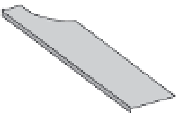Geology Reference
In-Depth Information
Box 6.1
Slip rates from fluvial terraces.
Conceptually, calculations of slip rates on fluvial terraces depend simply on two attributes: the
age of an offset geomorphic feature, and its magnitude of offset. Displaced terrace risers are
commonly used to determine slip magnitude, but along strike-slip faults, a choice arises as to
whether the age of the upper tread (at the top of the riser) or the lower tread (at its base)
should be used to calculate a rate. Because the lower tread is always younger, its age will yield
a faster rate for any given offset. But, is that rate accurate?
Many studies have systematically used lower tread ages and have typically justified this
choice by arguing that, as long as the active channel is flowing on the lower tread (the channel
has not incised to a still lower level and abandoned the terrace), the channel can bevel laterally
into any offset riser and modify its geometry. In the extreme case, such beveling can remove
any accumulated offset. In such a case, the riser begins to record slip only after the lower tread
is abandoned, such that the age of lower-tread abandonment would be the appropriate age to
use in slip-rate calculations. On the other hand, even when the lower tread still has an active
channel somewhere on it, if an offset riser on the downstream side of a strike-slip fault is
moved laterally away from the zone of erosion by the active channel, the total magnitude of
offset may be well preserved, such that the age of the upper tread would be the appropriate
one to use in a rate calculation.
Hence, any field geologist has to ask whether specific criteria can be used to choose between
using an age for the upper tread or for the lower tread. Several studies have focused on how
Lower Terrace Reconstruction
no riser offset
preserved
equal offsets of riser
& lower tread
riser crest
Da (upper
offset)
riser base
eroded
eroded
Do = Dl
Du = Da + Dl
riser
Dl
E = Da
A
C
B
Slip & Lateral Erosion
Incision, Slip & Lateral Erosion
Upper Terrace Reconstruction
equal offsets of riser
& upper tread
Do = Da +Dl
Du = Da + Dl
Da
Dl
sc
sc
E = 0
E
F
D
sc = shielded corner
Slip
Incision & Slip
Do = total observed riser displacement
Du = total displacement of the upper tread after its abandonment
Dl = total displacement of the lower tread after its abandonment
Da = displacement of the upper tread after its abandonment but before incision of the lower tread
E = lateral erosion of the displaced riser after abandonment of the upper tread but prior to incision of the lower tread
Conditions that favor either using the age of a lower terrace tread (A-C) or an upper tread (D-F) to calculate
slip rates along a sinistral strike-slip fault. Modified after Cowgill (2007).

























































































































































































































































































































































































































































































































































































































































